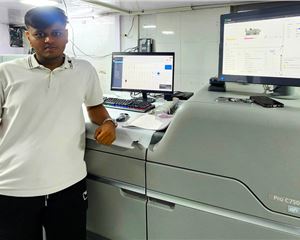Indian packaging industry - at a glance - The Noel D'Cunha Sunday Column
Packaging is the fifth largest sector in India's economy and is one of the highest growth sectors in the country. And to the Packaging Industry Association of India (PIAI), the sector is growing at a CAGR 22% to 25%
11 Dec 2022 | By Noel D'Cunha
The country’s paper industry needs investments of Rs 90,000-cr by 2030 for adding capacities to meet demand. AS Mehta, president and director of JK Paper highlighted that the paper major has a good CAPEX in the pipeline.
JK Paper's Sirpur plant is expected to further scale up to 95%. This will add to volumes plus there is a strong demand for packaging boards - also ramped up due to the Gujarat plant.
The results declared on 14 November suggest revenue guidance from Rs 3000-cr to Rs 3,500-cr. The reason is three-fold: Finland’s UPM plant shut for the last two months, this has resulted in higher exports from India to EU; coated paper prices have risen by 7-10% and office demand is back to pre-Covid levels.
The company’s mission is to be the manufacturer of paper and paperboards, to the tune of 1.0 million tonnes by 2030.
Meanwhile, the TNPL numbers are staggering. During the last year, TNPL has produced 3,88,881 metric tonnes of paper and achieved paper sales of 4,38,010 metric tonnes. With the commissioning of a multilayer double-coated board plant, TNPL has made a foray into the packaging board segment. TNPL has produced 1,83,770 metric tonnes of packaging board and achieved packaging board sales of 1,84,546 metric tonnes.
Today, TNPL has emerged as the third-largest player in the Indian paper industry. The pulping capacity increased from 300 tonnes per day in 1984 to 1,180 (tonnes per day).
This year, the general sale of machinery in the paperboard conversion segment is projected to rise by 25% to 30%, indicating that the industry is investing in conversion machines.
The ascendancy of adhesives
Today, the Indian packaging industry was about USD 31.7-bn in 2015. It has grown at a CAGR of 18% till FY20 – to an estimated USD 72.6-bn, according to an ASSOCHAM-EY joint study.
One key trend we have picked up is how adhesives have moved from 30% solvent-free to 55% solvent-free usage among the packaging industry converters. If earlier it was one solvent-free product that was being launched, now it is five products. This is an important sustainable drive.

The humble brown box
Meanwhile, some data about the corrugation brown box industry.
The industry's size in terms of kraft paper being converted is 8-mn MT per annum. Today, there are about 500 automatic plants with a capacity ranging from 6,000 TPA to 60,000 TPA. In addition, there are 10,000 semi-automatic plants with a capacity from 1,000 TPA to 3,000 TPA. The industry value is estimated at Rs 40,000 crore.
As and when the USD 3.1-tn economy grows to a USD 5-tn economy, this number for the corrugation box industry is expected to be 18-mn MT per annum. If the manufacturing index sees a boost (due to PLI and atmanirbhaar) in the next three years, this number could be 20-mn MT per annum.
On the flip side, Diageo’s has decided to phase out use of gift boxes and surplus packaging. The Corrugation Packaging Manufacturers Association has commented on the potential wider implications on the packaging industry due to Diageo’s decision. But the question is: What will be the real impact? Will it spread to other industry?
But Apple and Samsung are increasing their mobile phone production in India, which will contribute to the growth of paper board and corrugation. Apple alone produces approximately 230-mn phones per year world-wide and a shift of 30 to 40% to India will have significant growth factor.

BMPA's Maharashtra survey about print says it is Rs 92,000-cr turnover in Maharashtra; plus 4.5 lakh print employees in Maharashtra; and Rs 13,000-cr print export (Rs 6,200-cr direct export plus Rs 7000-cr indirect export)
Boost from food growth
The BCG India food report inaugurated during the 14th edition of FICCI's Food World India, speaks about the potential of the food processing industry. The number is staggering: a trillion dollars of food is traded today.
Today the Indian print and packaging industry consumes 1-2% water-based inks. Of this toluene-free is 15-20% (this includes gravure + flexo); the rest is toluene-based. Both toluene-free + toluene-based contain solvents.
The point is, the solvent-free drive has just begun in India.
Toluene-free inks are at 20% base. Many converters (Indians and MNC converters) are using toluene-based inks. Non-toluene is not the norm.
However, recently solvent cost for non-toluene has been on a downtrend, and some converters may move towards that segment.
Indian ink snapshot
The packaging industry in India is at crossroads. The brands must address the Indian ethos, in terms of price points, and products without compromising their commitment to society and the environment. Most brands, be they Indian or global, have emerging sustainability guidelines, which are often non-legislation dependent.
As Manish Bhatia, the managing director and CEO at DIC India, says, "India is a young country, and I see an increasing trend from the younger generation, who are looking at accessing sustainable products. Similarly, there is increased health awareness, especially during the post-Covid years."
Most ink majors have strong manufacturing and R&D footprints in India. The manufacturing footprint in the ink industry in India is allowing the ink majors to bring these technologies together. The buzzword is: Developing products for global consumption in India, as well as introducing them for the Indian market.

Broadly speaking, the water-based flexographic inks sector is very minuscule now. It would be less than 5% of the market. The toluene-free ink is close to 15% to 18% and fast expanding. So that’s a heartening sign.
With regards to the solvent element, its reduction has also had to do with an interesting factor, which one might miss out on. Solvent recovery and recycling are becoming a norm in Europe, and it is also being adopted by a few other countries. Many plants in India have a solvent recovery plant and have invested in the solvent recovery process.

As an ink MNC CEO shared with us, "We use the recovered solvent for a captive consumption which overall reduces our commitment to what we buy."
Plastic consumption
A quick glance at the Indian packaging industry suggests that if the size of USD 50-53 bn; then rigid packaging forms about 86% and flexible is 14%; with a growth of 11-12% per annum. The predominant flexibles packaging focus is on consumer-focused flexibles packaging segments. The fastest growing sub-segments are F&B and hygiene.
We see traction in plastic consumption in India. This has grown 235% since 1990. It stood at 20.8 million MT in 2021-22 and is estimated to reach 22 million MT in 2022-23.
Today it is among the top 10 items to be exported from India. And so, plastic exports in 2019-2020 were USD 10-bn and is expected to reach USD 25-bn by 2025.
The plastic industry provides jobs to 4 million people and comprises 35,000 processing units, 80% of which are small and medium-sized enterprises. This sector is predicted to achieve 9.1 lakh crores by 2025.
In 2021-22 the consumption of plastics was approx. 22 MMT, compared to 0.9 MMT in 1990. The industry gives over 4 million people jobs and comprises over 35,000 processing units, 80% of which are small and medium-sized enterprises. This sector is predicted to achieve 9.1 lakh crores by 2025.
And what about the sustainability factor? The Plastindia Foundation says, "The plastics industry is committed to sustainable development. 90% of rigid plastics, including PET bottle waste, and 60% of flexible waste is being recycled. 6.4-million MT is estimated to be recycled in 2021-22, which is 60% of the plastic waste stream.
Fund infusion preps projects
We have seen an inflection point in the packaging sector since 2019. The entire packaging sector saw Rs 177-bn of capital inflows from 2019- 2022 as opposed to Rs 39-bn from 2015-18.
Over the last 18 months (2021-2022), the entire packaging sector saw two-third of capital flowing into the flexible packaging sector. Since 2019, private equity players have been more active than strategics in fuelling growth capital to the packaging companies. The prominent players in the packaging industry are – Blackstone, Premji Invest, Warburg Pincus, and Advent among others.
R Senguttuvan, principal advisor of Sven Consulting, said, "Private equity players have invested Rs 183-bn in the sector. This represents 85% of the total capital invested in the Indian packaging sector".
Of the total capital invested by the private equity players, the flexible packaging represents 40% share. In the last three years, Rs 55-bn has been invested in the flexible packaging space by global as well as domestic private equity players.












 See All
See All